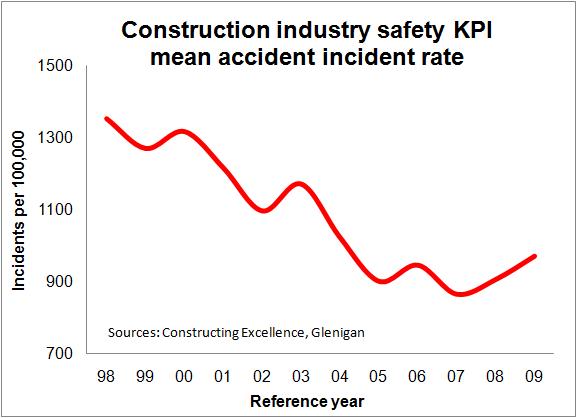New KPIs show construction is getting more dangerous
The construction industry is getting more dangerous as the recession bites. That seems to be one message from the latest industry Key Performance Indicators.
The construction industry KPIs for 2010 were unveiled earlier this week and as a package they paint and interesting picture of how the industry is responding to the downturn in work.
 But it was the health and safety indicator that caught my eye. The results can be seen on the graph and it is worth noting that the 2010 KPIs refer to performance in 2009. So the figures in the graph show the average number of reported accidents per 100,000 hours worked in the year recorded.
But it was the health and safety indicator that caught my eye. The results can be seen on the graph and it is worth noting that the 2010 KPIs refer to performance in 2009. So the figures in the graph show the average number of reported accidents per 100,000 hours worked in the year recorded.
The graph shows clearly how the safety record of the industry was steadily improving up to and including 2007, with the exception of a few annual blips such as in 2006. But the trend appears now to be in reverse.
So what is going on?
The details at the launch were presented by Allan Wilen, economics director at the information provider Glenigan, which is now engaged in putting together the figures.
He raised the issue of this worrying trend in the figures and pointed out that the prevailing view at the health and safety watchdog HSE was that a recession normally produced a reduction in the accident rate. This was, to say, the pattern historically.
And you can see plenty of reasons why this might have been so.
With falling workloads there are fewer less experienced workers and managers on site, so you reduced the proportion of those more prone to accidents. Some of the urgency in the build programmes and corner cutting resulting from overstretched resources might be reduced. And some of the flakier businesses with worse safety records might go to the wall.
This probably still holds true.
So why is the industry seemingly getting more dangerous as this recession bites?
Allan wisely pointed out that more research would be useful. He equally wisely suggested that one explanation could be that the loss of flakier firms might potentially distort the figures upward. Yes these firms might have worse records in practice, but these firms are more likely, one might suspect, to being guilty of underreporting accidents.
There are plenty of other reasons why the figures could have moved sharply up or down as a result of a recession as profound as the industry is facing, not least that the mix of work will have changed and with that the balance of relative risks.
One always has to be careful when looking at statistics to be sure that what you think you are looking at is actually what you think it is.
But for me there is and has been for some time a powerful reason to fear an upswing in site accidents if recession cut deeply this time around.
The cultural changes within the industry prompted in part by Latham and Egan brought us better site supervision and management which in turn has yielded improvements, most notably in health and safety. But this is now under pressure as cost cutting takes precedence over the drive to improve value.
In October 2008 I wrote about the inevitability of the industry heading into a deep recession and a new bout of suicidal bidding.
I asserted then that: “This will cause a breakdown of trust. It will cause a harmful spiral of negative price bidding. It will lead to worse health and safety and more death. Worse site practices and more disputes. And inevitably it will lead to a worse product.”
I feared then that the strides made to put in place management structures for better oversight would be threatened. These systems come at a cost, but they pay back hugely in terms of value and reduced risk.
But even then subcontractors were telling me that they were being pushed to the limit. They had little option but to put some of those who would have been primarily engaged in oversight back on the tools. The industry was cutting costs, but increasing risks.
For years we had to accept hand wringing and platitudes by industry bosses over its appalling health and safety record. It was a national and industry disgrace.
The past 10 years or so have seen the installation of a new generation of managers who in sufficient numbers give a real damn about health and safety. And there have been enough of them to have made a difference.
There is now, of course, an added incentive for those managers not so emotionally committed – the threat of corporate manslaughter.
While, the improvements have not been “outstanding” and the industry remains a dangerous place, the graph shows the improvements have been profound.
There will be many a construction worker walking the streets today who might in yesterday’s world have been pushing a wheelchair. They will be many families not deprived a parent.
So the effort to change the culture of safety within the industry should be applauded and not lightly dismissed.
As I see it this recession is different with respect to health and safety. We have much more to lose – the gains the industry has made over the past decade. That will be a high price to pay.